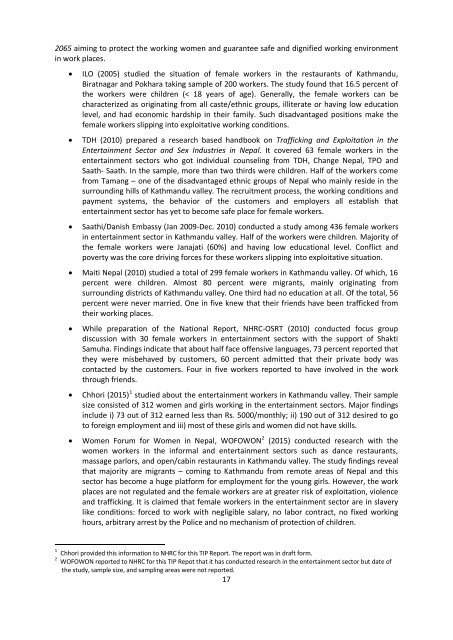TRAFFICKING IN PERSONS
397604438Trafficking_in_Persons_National_Report_2013-15
397604438Trafficking_in_Persons_National_Report_2013-15
You also want an ePaper? Increase the reach of your titles
YUMPU automatically turns print PDFs into web optimized ePapers that Google loves.
2.4 Trafficking of Girls to Korea and China for the Purpose of Marriage<br />
South Korea and China are facing two fundamental demographic problems: first, they have<br />
experienced low fertility. South Korea had one of the lowest Total Fertility Rate (TFR) in the world:<br />
1.2 TFR per woman and China had 1.7 TFR in 2013 (http://data.worldbank.org/indicator/SP.DYN.TFRT.<strong>IN</strong>).<br />
Second, in particularly in China, there has been ‘missing girls’ phenomenon (sex selected abortion).<br />
The sex ratio at birth in China is estimated to be 117.8 in 2011 (UNFPA, 2012). This means that there<br />
are 117.8 boys born to the 100 girls born. The sex ratio at birth in South Korea is estimated to be<br />
106.7. Note that the biological sex ratio at birth should be around 105 in any population. This<br />
situation has created in the imbalances in population between female and male – more males over<br />
females means that males will not have females to marry.<br />
As discussed on Chapter six (Law Enforcement Section), the CIB Nepal Police arrested the rackets<br />
involved in trafficking of young girls to Korea and China for marriage. This is also widely covered in<br />
media. The Kathmandu Post – a Daily English Newspaper writes:<br />
Mar 7, 2015 - The Central Investigation Bureau (CIB) of Nepal Police on Friday made public three persons<br />
from Chheru International Pvt. Ltd., a marriage bureau that lures young girls into ‘paper marriages’ with<br />
Korean and Chinese men. Pasang Sherpa, Bipul Nagarkoti and a Korean National—Park Hue Cheung—<br />
were running the Bureau registered nine months ago, pairing girls as young as 17 years with men twice<br />
their age. Speaking at a press conference, CIB Director Hemanta Malla Thakuri said the arrest was just<br />
the tip of the iceberg. ‘The magnitude at which this organized crime is being carried out is still being<br />
investigated. It is hard to point out the numbers but we can tell it is huge,’ said Malla.<br />
High demand of girls for marriage in these countries coupled with poverty and unemployment in<br />
Nepal are the crucially important determinants of vulnerability of trafficking of girls for marriage.<br />
Trafficking for marriage is a growing phenomenon in Nepal. Based on the Monitoring Report of<br />
NHRC in South Korea, the OSRT-NHRC TIP National Report 2009/10 estimated that there are at least<br />
1,000 female migrants who went to South Korea through marriage in between 2005 and 2013.<br />
About 300 are happily married while others are in slavery like condition. The Migrants Centre of the<br />
Asian Human Rights and Cultural Development Forum has been investigating complaints of paper<br />
marriage. It says, ‘hundreds of Nepali women from the country’s rural areas are trapped in Asian<br />
countries, especially South Korea’. In one fake marriage case, it says, ‘the recruitment agency got Rs.<br />
800,000 to Rs. 120,000. The agent pocketed Rs 500,000 and the rest was spent on marriage<br />
expenses and documentation’ (http://www.emirates247.com/news/fake-agents-trapping-nepaliwomen-in-foreign-marriages-2014-06-28-1.554586).<br />
Source:http://kathmandupost.ekantipur.com/news/2015-03-07/trafficking-in-disguise-china-korea-marriage-racketbusted.html.<br />
Source: PPR Nepal, 2015.<br />
Initial investigations show that there are at least 83 such bureaus operating in Nepal. All<br />
marriages are registered at District Admistration offices in Kathmandu, Lalitapur and Bhaktapur.<br />
However, there is lacking of authentic data revealing the magnitude of marriage bureaus<br />
registered in Nepal. Further, there is no information/data about the paper marriage already<br />
conducted, the profile of the victims (origin district, age, education, caste/ethnic groups). Much<br />
research is needed to understand the magnitude and processes of trafficking of young girls for<br />
marriage in order to setting policies, rules and holding discussions with destination countries and<br />
with different law enforcement stakeholders (MoWCSW, 2015).<br />
2.5 Trafficking of Human Organs<br />
The UN Protocol on trafficking 2000 and HTTCA 2007 define that the extraction of human organs,<br />
except as otherwise determined by law, is an act of human trafficking and transportation. The<br />
Previous National Report 2009/10 of the OSRT-NHRC on Trafficking in Persons, Especially Women<br />
and Children highlighted how the racket of trafficking of kidney was extended from village to<br />
19


